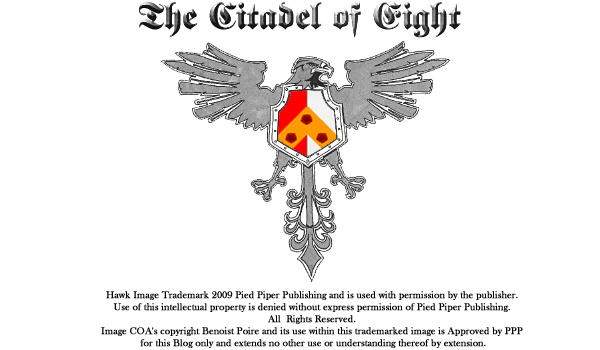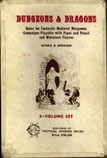This certainly was partly consequential of 3rd edition’s “back to the dungeon” mantra, and surely, early actors of the “old-school” scene like Necromancer Games, Goodman Games or the Troll Lords, and even other publishers like Green Ronin (via the Freeport series, for instance) and Malhavoc Press participated to this phenomenon (Monte Cook often speaks of the importance of modules and adventures for the game, and his designs constantly stress the role of the DM as the final arbiter of what would be appropriate or not at his game table).
In hindsight, these concepts influenced me greatly when I came up with the idea of a Black Abbey of Saint Yessid, which in turn kicked off my return to the roots of the game along with my come-back to the Internet. As I wrote random thoughts in my diary of the Summer of 2008 I would constantly go back to the

A massive monastery on top of a narrow island surrounded by an entire village and micro-economy presented all the requirements for a dungeon delve: the monastery could hide an entrance to underground levels within the island and beyond, the village would provide the basic necessities of visiting adventurers, the monks themselves could be used for a host of character interactions, and the list went on. It was as if this place begged to be used as a gaming template.
As I started conceptualizing the dungeon environment, I found myself reaching to landmarks of the genre such as the Ruins of Castle Greyhawk, Undermountain, Rappan Athuk, Castle Whiterock and others.
The idea clearly was to share this dungeon setting with others. To this end, I thought of ways in which I would present the design with an eye for maximum versatility and adaptability at a DM’s game table. I wanted a sort of micro-Ptolus with a Gygaxian approach avoiding the natural pitfalls of modern campaigns such as plot points, railroading and narrow tactical situations. I wanted Lego-elements presented in a straightforward, direct-to-the-DM fashion. A conversational tone which would not take the DM for some sort of uneducated, incompetent and/or lazy individual, a Temple of Elemental Evil spelling out ways in which to use it as a base for decades of gaming.
Talk about ambition.
 Later in the year I acquired Castle Zagyg vol. 2, The Upper Works and was blown away by the general feel of the product. Along with vol. 1, Yggsburgh, it was presenting to me clearly, black on white, the sort of tone I wanted to achieve.
Later in the year I acquired Castle Zagyg vol. 2, The Upper Works and was blown away by the general feel of the product. Along with vol. 1, Yggsburgh, it was presenting to me clearly, black on white, the sort of tone I wanted to achieve.From there, I would reconsider using Castles & Crusades and would research as much as I could about the origins of the Castle. This would obviously lead me back to Castle Greyhawk and the original
This is around this time that I would get back to the Internet and find out about Greyhawk Grognard, Grodog’s Greyhawk, which would in turn lead me, along with various discussions on message boards, to Pied Piper Publishing and Rob Kuntz’s Lord of the Green Dragons.
That’s when all the pieces really started to fall into place. I would come back to the idea of running games with my better-half with a new eye for something I have been missing for years in my gaming: enchantment. I liked (and still like) C&C a lot, but would find myself house-ruling from the get-go, mainly because of instances of dissociated game mechanics with class abilities and math/design issues with its SIEGE components.
As I read more and more about the Lake Geneva campaign, the idea of making the game my own, of taking the simplest expression of the game and rebuild it from the ground up to my liking made its way in my writings. I would have a second look at the original booklets and their supplements and find that my appreciation had evolved over time. This was not a complete game. This was a tool, a gate to build my own game.
With this simple realization I would read through the World of Greyhawk and think to myself: “if the rules-as-written are the gateway to my own game system, what if I treated Greyhawk not as a complete setting, but as a gateway to my own setting?”
Writing this now I realize how it might seem obvious to many of you, but at the time these thoughts struck me powerfully and initiated a full-blown epiphany on my part. I had already created a new map mixing different setting elements to play with Nerissa, but with these thoughts in mind would just go back to the vicinity of Greyhawk and decide to use the Flanaess from there.
I would find an appropriate location for the Black Abbey on the shores of Nyr Dyv’s Midbay (hex. A4-118), plug Yggsburgh at the confluence of the Ery and Neen rivers (hex. D4-84) and Chordille Keep (from dungeonaday.com) between the two (hex. C4-82). I strongly doubt all these locations will be visited during the course of the solo games I’m planning, but it is part of the process of making sense of Oerth for myself.
This is where I am now, in a nutshell. I will of course explore the evolution of these ideas through this blog. The Black Abbey itself will be discussed at length, as well as the way I mesh Nerissa’s desires with the way I’d like the campaign to work out for myself. There’ll be much more to come, but there you have it: how I reached this point in time, and from there, what I hope to accomplish in the near future with my gaming.







No comments:
Post a Comment